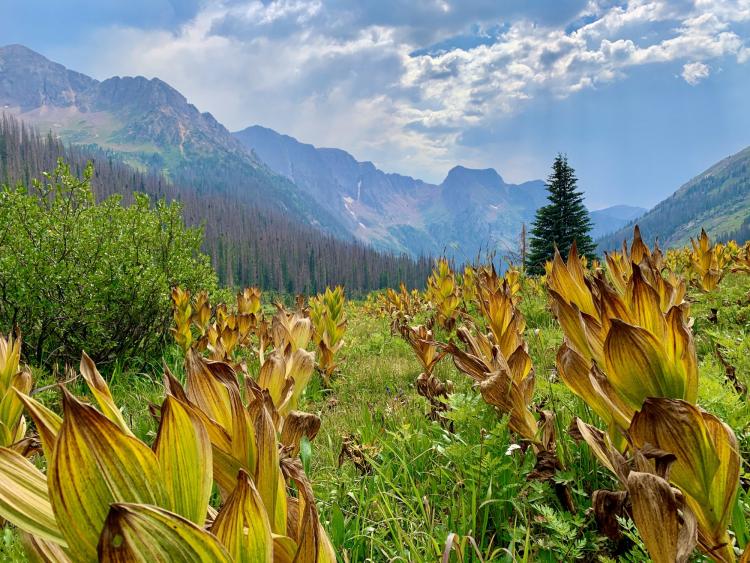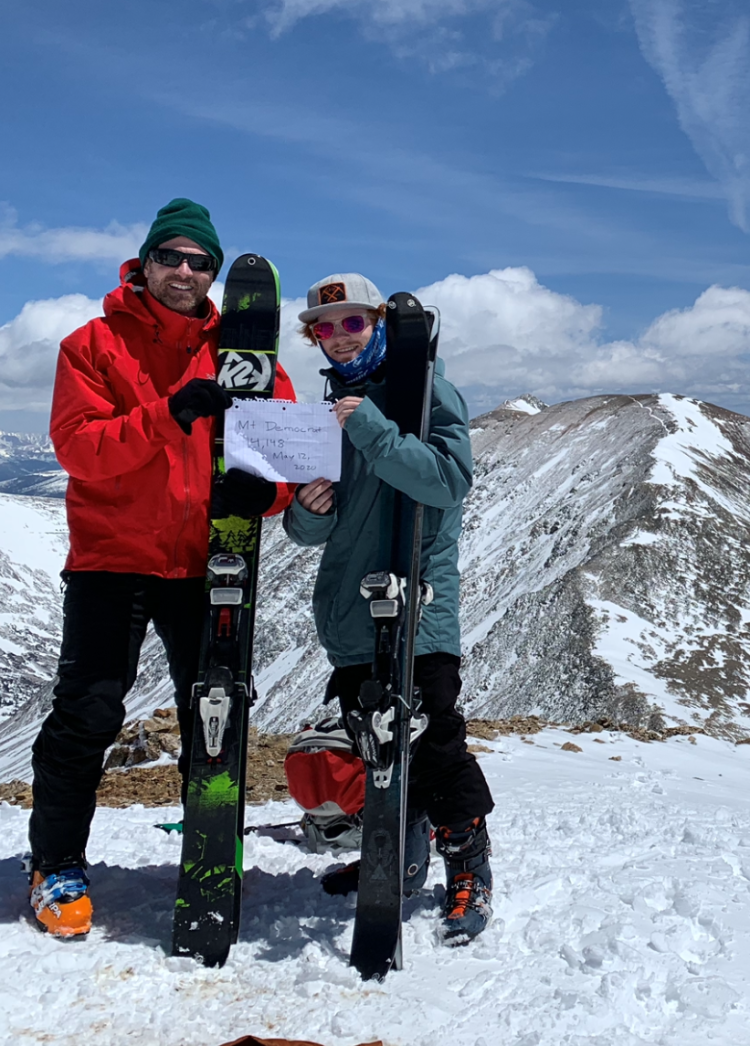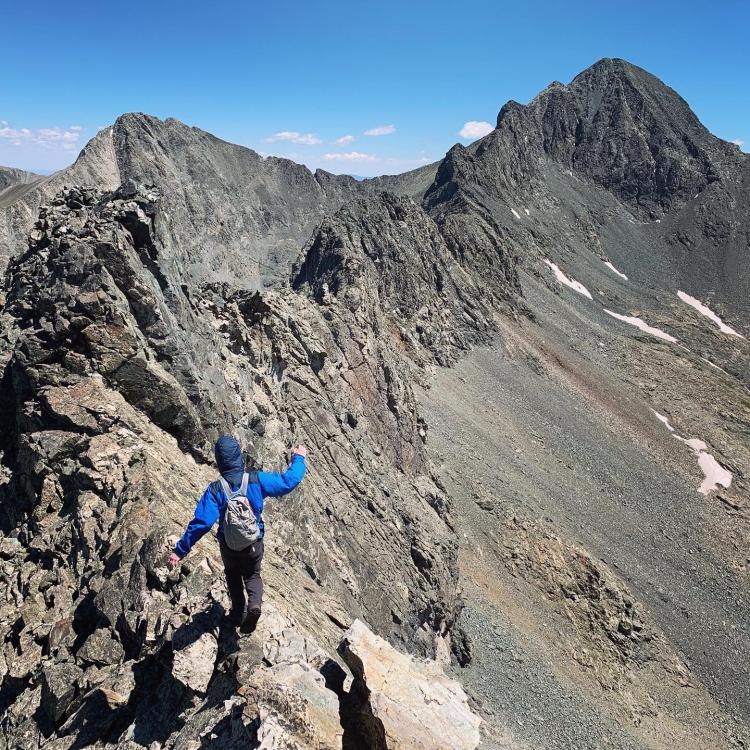Finding Myself on 14ers
The wind was howling, the San Juans were expressing the full beauty of her forests and mountains and lakes, and my Dad and I were in utter heaven, standing upon a 14er. Here was the feeling of mountaineering, when success is gifted to you by the conditions and by the hard work of preparation; to stand on a place of natural significance such as a mountain peak, one begins to understand their relation to nature, and it’s uncaring for your presence.

I feel that on my journey to summit all 58 14ers, I have earned my way to the top of every single one, and it stands to reason that anyone reading this could benefit immensely from an experience like I have been fortunate enough to have. Between May 6th and September 13th, 2020, I spent, on average, 5 nights a week camping (almost always under the stars), 4-5 days a week on treacherous mountains carrying out grueling hikes and climbs, and battling many things: cold, heat, hunger, blisters, harsh sun, strong winds, snow, rain, hail, rock-fall, avalanche conditions, bugs of all sorts, sore and aching feet and back, long drives, fear, anxiety, exhaustion, boredom, and aloneness. Spending so much time enduring these harsh afflictions has made me stronger, and ready for more. I do not wish to spend any more of my life climbing easy peaks, as I only look forward now to more difficult, more technical, and more famous routes up peaks all over the world.

Prior to this year, I had climbed 11 14ers and all of these (with the exception of Longs Peak) were class 1 or 2. I wanted to do harder routes up some of the 14er’s than their respective standard routes because I knew I would learn more from a more technical challenge than from more basic walk ups. I thus decided to include a mini-challenge to my already massive challenge: I completed the 4 Classic CO 14er traverses in addition to the 58. These are 4 routes that each connect 2 14er’s together, and all 4 are rated either class 4 or class 5 (class 5 is defined as full-on rock climbing). I couldn’t wait to tackle this challenge, since these were all amazing routes that showcased the dramatic nature of Colorado. I planned to do all 4 routes in July, when I would already be in good shape for the ‘marathon days’ many peaks required and when I would also be prepared for the mental challenges that are present in addition to the physical difficulty of these routes.
My first traverse was the El-Diente-Mt Wilson Traverse. My dad and I drove from Erie, CO to the Wilson Group near Telluride, CO. We slept in the parking lot, then the next morning we backpacked up to Navajo Lake in the middle of the Wilson Group. We then summitted Wilson Peak, the peak on the Coors Light can. It was a neat experience to be standing on the top of a mountain as famous as Wilson Peak. The next day, we attempted the traverse. After climbing up a 2000 ft, class 4, loose buttress to reach the summit of El Diente Peak, we began to make our way along the connecting ridge to Mt Wilson. The biggest challenge of this traverse is that the entire Wilson Massif is incredibly loose, and we were traversing along a ridge with thousands of feet of exposure underneath us. We had to have good patience in our footing to not fall, confidence in our route-finding, a stable weather window, and speed in order to make it across and up class 4 climbing safely with potential afternoon weather rolling in. This was my dad’s first class 4 14er, and we successfully made it! After about 2 hours of delicate route-finding, we summitted Mt Wilson. The wind was howling, the San Juans were expressing the full beauty of her forests and mountains and lakes, and we were in utter heaven, standing upon a 14er.
The uncaring of nature for your presence must always remain in your mind and in your decision making. Mountains, especially, are treacherous, but it is the very danger of them that appeals to me and others. You must mentally be tough in order to overcome danger. Being tough in the mind is the most important thing I learned this summer, because it will allow me to overcome any obstacle that is presented to me in the future. Being tough in the mind allowed me to complete my goal of exploring Colorado in a most classically-Colorado style, by climbing its tallest mountains.
The best day of my summer was on my last 14er, but not because it was the last one of the project. It is because, on September 13th, I did the most advanced mountaineering route I’ve done to date. As number 58, the last peak in my project, I summitted Longs Peak via Kieners Route. Longs Peak, the mountain that inspired me from the time I moved here to climb, can be described as the perfect mountain. It offers great potential for every discipline of mountain climbing: hiking, skiing, rock climbing, ice climbing, high altitude, and even big wall climbing, and Kieners route is the most classic mountaineering route on the peak.
You all may remember that Colorado got a very early snowfall on September 8-9, only a few days prior to my climb of Kieners route, making conditions much more difficult than usual for mid September climbing. This snowfall actually made me enjoy the final peak of my project much more because I think it squeezed out every ounce of the potential of mountaineering. I learned how much more I had to learn, how much more I wanted to do, and how far I had to go to reach my goals. However, it also showed me just how much I’ve learned this summer. At the beginning of the summer, I was nervous about doing even a class 3 climb. Now, I was doing Kieners Route, a famous route on a very famous peak.
My dad, his pilot friend Steve (an accomplished mountaineer who has been on 6 Alaskan expeditions, multiple ice climbing trips to Scotland, and an attempt of the Eiger North Face), and I all set off from the Longs Peak trailhead at 1 AM. We hiked up the standard trail for a few hours, then eventually turned off the trail towards Chasm Lake. We began seeing snow on the ground once we were near the Lake, which was also when we transitioned into our technical gear. We were going to simul-climb Lambs slide, with Steve leading, my dad in the middle, and me at the end, cleaning the route. With crampons on and ice tools in hand, we started up Lambs slide, a long 1000 ft, 50 degree snow-couloir with exposed black ice in various spots. Steve put in pro periodically along climber’s right of the couloir. We made good time, moving up Lambs Slide, with the sun rising just as we began climbing from the base of the couloir.

I made it back to the car around 10:15 pm. This was a 21 hour day, by far my longest day of the season, and it was the best day of my life. I had the best summer I’d ever had, and I am very grateful for all my experiences with nature. I am also extremely grateful for the people that aided me along the way, and I want to thank the following people: Alec Vanlandingham, my climbing partner on many summits, Steve Towne, who allowed me to have the best and most inspiring day of my life, and my parents, Geoff and Amber Warlock, who have always been my heroes and my biggest supporters. The 14er project is now part of me, and I hope to continue building upon it in the future with bigger and harder peaks and challenges.


